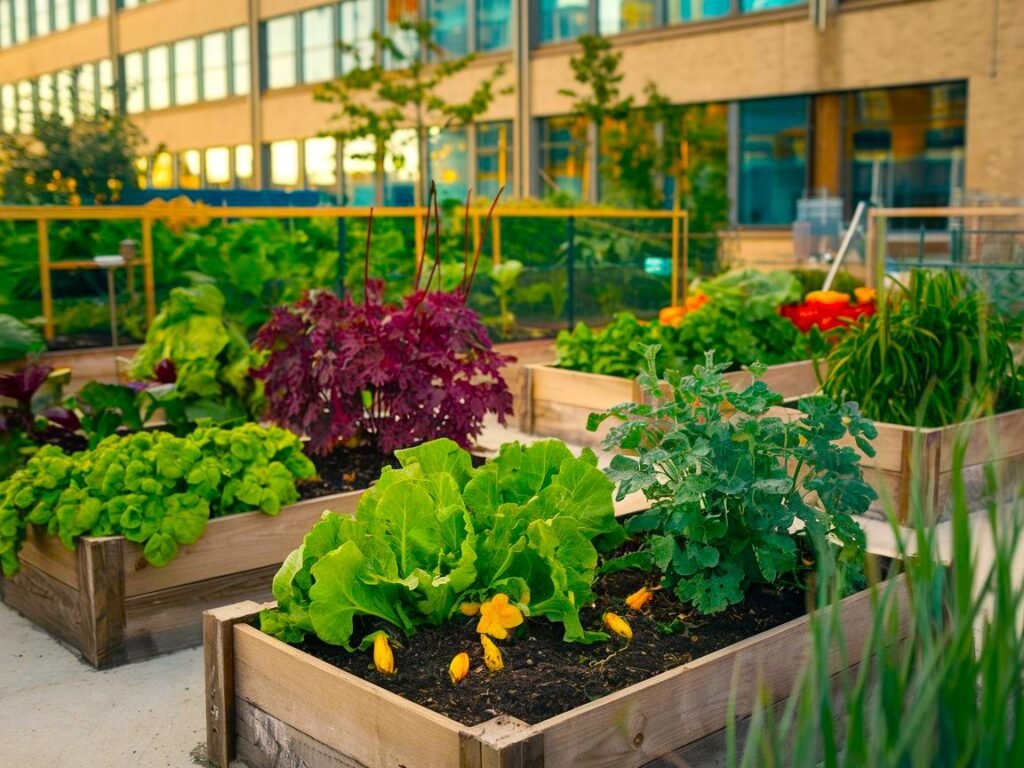Introduction
Imagine going out to your porch or roof and selecting clean and home vegetables for dinner. It looks super, right? Urban gardening of vegetables is putting this dream actually for hundreds of many human beings around the arena. It is larger than just a trend – miles is an alternative way of life. With advantages like higher nutrition, price financial savings, and reduced environmental effects, developing your personal greens is something everyone can try, even in small spaces. so lets learn about Urban Vegetable Gardening.
Getting Started with Urban Gardening
Understanding Urban Gardening
Urban gardening refers to developing vegetation in metropolis environments, often in compact spaces. Whether it’s a balcony, rooftop, or maybe a sunny windowsill, you could remodel any to be had spot right into a productive vegetable lawn.
Assessing Available Space in Your Home
Take a great look at your own home. Do you have got a small patio? A sunny nook in your kitchen? Even a vertical wall can emerge as your gardening haven. Urban gardening adapts to whatever area you have got available.
Choosing the Right Gardening Method
Depending in your area and assets, you may pick from several gardening methods:
- Container Gardening: Perfect for balconies and patios. You can grow veggies in pots, buckets, or repurposed boxes.
- Vertical Gardening: Ideal for small spaces, the usage of trellises, striking planters, or wall-set up systems.
- Hydroponics: A soil-unfastened method that’s tremendous for interior and gives green effects in tight areas.

Selecting Vegetables for Your Urban Garden
Best Vegetables for Beginners
Starting out? Go for low-upkeep alternatives like lettuce, spinach, radishes, and cherry tomatoes. These are smooth to grow and produce quick outcomes.
Seasonal Considerations
Always remember the season. Leafy veggies thrive in cooler months, at the same time as cucumbers and peppers love the summertime warmth.
Factors Influencing Vegetable Selection
- Light availability
- Container length
- Personal preference (grow what you love to consume!)
Setting Up Your Urban Garden
Choosing the Right Containers and Tools
Opt for light-weight, durable boxes with proper drainage holes. For equipment, a small trowel, pruner, and watering can are crucial.
Preparing the Soil for Maximum Yield
Good soil is fundamental. Mix garden soil with compost or organic count number to create a nutrient-rich environment to your vegetation.
Arranging Proper Drainage and Sunlight
Place packing containers wherein they acquire as a minimum 6 hours of sunlight day by day. Indoors, don’t forget grow lighting fixtures for added help.
Soil and Fertilizer Management
Selecting Nutrient-Rich Soil
Invest in excellent potting soil, because it’s designed for box gardening and retains moisture well.
Organic vs. Chemical Fertilizers
Organic fertilizers like compost and malicious program castings enhance soil fitness obviously. Chemical options are quicker but may harm the environment.
Composting at Home
Turn kitchen scraps into black gold! Composting is an excellent way to recycle organic waste and feed your plants.

Planting Your Vegetables
Step-by-Step Planting Guide
- Fill your container with soil.
- Sow seeds or transplant seedlings at proper intensity.
- Water gently and usually.
Spacing and Arrangement Tips
Avoid overcrowding. Each plant dreams of enough space to increase and get admission to daylight.
Planting Basic Companion
Empire very suitable plants such as basil or carrot tomatoes with onion to decorate the increase and stop that pests.
Urban Gardening Challenges and Solutions
Common problems in small space garden
Limited location and day are common disturbing situations, but can be managed with intelligent planning and revolutionary responses.
Pest Control for Urban Gardens
Use natural remedies such as neem oil or introduce beneficial insects, such as ladybugs to keep pests away.
Dealing with Limited Sunlight
Cultivate tolerant vegetables in color such as lettuce and kale or invest in the development of lights for internal settings.
Maintaining Your Urban Vegetable Garden
Daily, Weekly, and Monthly Tasks
- Daily: Make sure the desired pests and water.
- Weekly: Pruning leaves lifeless and investigating through disease.
- Monthly: add fertilizer or compound.
Pruning and Harvesting Tips
Wait for flora regularly to encourage a healthy increase. Che reap the vegetables while mature to ensure the first class taste.
Recognizing and Treating Plant Diseases
Observe the yellowish leaves or atrophied growth. Treat problems early with natural treatments.

Harvesting the rewards
Harvesting Your Vegetables
Choose your greens on the peak maturation for satisfactory flavor and vitamins.
Store and preserve products
Store the arbor vegetables in the refrigerator and freeze or sting the surplus of products for later use.
Incorporating Your Harvest into Meals
From smooth salads to healthy soups, their home vegetables increase each plate.
Sustainability in Urban Gardening
Ecological Gardening Benefits
Urban gardening reduces its carbon footprint, reduces food waste, and promotes self-sufficiency.
Tips for Reducing Waste
Reuse containers, compost scraps, and water plants with collected rainwater.
Rainwater harvest in urban environments
Set up an easy rain barrel to collect water on your lawn. It’s cost-effective and eco-friendly. learn mor about Rainwater harvest here.
Inspiring Urban Gardening Ideas
Creating Aesthetic Garden Designs
Blend functionality with beauty by adding decorative pots or arranging plants creatively.
Mixing Vegetables with Decorative Plants
Combine edible and ornamental plants for a stunning garden that serves multiple purposes.
Adding exclusive features such as herb walls
An herbal wall is not thin in a neighborhood, but it also offers an aromatic fascination with your private home.
Conclusion
Urban vegetable gardening is an experience that is worth nature at the door. It is larger than just developing foods-it is an adventure of self-confidence, sustainability, and joy. No matter the dimensions of your area, you can create a thriving lawn and revel in the blessings of clean, homegrown vegetables.
FAQs
- What are the easiest vegetables to grow in an urban garden?
Lettuce, spinach, radishes, and cherry tomatoes are amateur-pleasant selections. - How many areas do I want for town gardening?
Even a small balcony or sunny windowsill is enough to get started. - Can I expand vegetables indoors without daylight?
Yes, you can use lighting development to replicate the light of a natural day for internal gardening. - How do I avoid pests in the garden of my city?
Use organic techniques such as neem oil, accomplice planting, or useful errors. - What are some green practices for urban gardening?
Composting, reuse of rainwater packaging, and harvesting containers are fantastic methods for lawn sustainable.




Pingback: How to Start a Balcony Vegetable Garden in Small Spaces - Green Leaf Path